Caladium leaves will dazzle in your garden with bold hues, showcasing an enchanting mix of reds, pinks, greens, and whites. Their semi-translucent nature allows light to play through, creating a captivating and radiant display in any setting. Here is help to buy caladium bulbs for your garden.
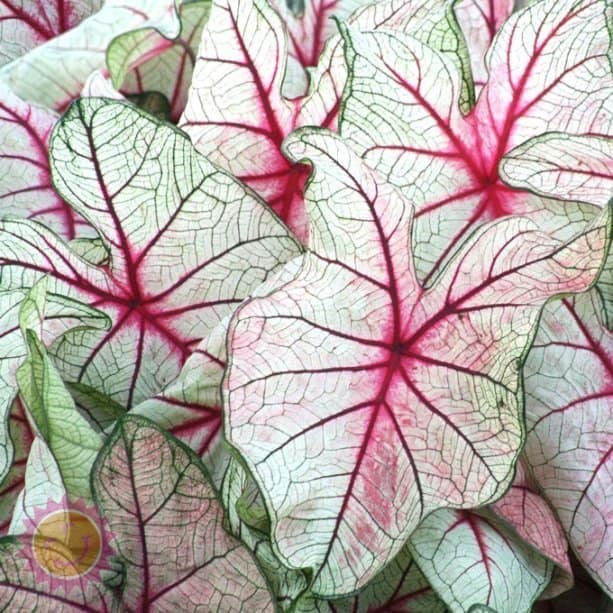
Are you planning for hot weather in your garden? It is coming sooner than you think. In our summer garden we love to see the translucent flags and vibrant colors of caladiums. Like a summer dress, the sight of their sheer leaves and delicate colored veining will cool the atmosphere. (Well, it seems that way!)
The best gardeners play a long game, always interested in the future, even with the color accents; always ready for the next season and the next year.
While weather is cold (or in my zone 10 garden, cool) is the time to plant for summer; and for planning ahead nothing is better, or more cost effective than planting bulbs! For the most perfect summer blooming bulb, in any climate, choose the caladium first. You won’t look back.
How to Buy and Plant Caladiums for Your Summer Garden
My Secret to Adding Caladiums to Your Summer Garden
In this story I’ll tell you how to buy caladiums to add something new to your summer garden this season. I have been doing this every spring and I love being able to create such a painterly display of ethereal sheer leaves colored in a dazzling display of color and texture. The plant has heart- or lance-shaped leaves that can reach sizes of up to 12 inches or more, depending on the variety. You will be able to use intricate patterns, vibrant splashes of red, pink, white, and green, often with prominent veins that create striking contrasts.
How to Find Caladiums And Buy Them
The caladium has established itself in warm climate gardens throughout the world and I sometimes see the plants enhancing planters and summer garden beds in cooler places. I find them so simple to use and the result so unique that I think they have a far wider application for far more gardeners.
Caladiums grow from a tuberous corm, you will see them commonly referred to as bulbs; the larger the tuber is, the more leaf buds it contains, so bigger bulbs will make a more lively display.
This chart shows the bulb sizes available when buying. Jumbo bulbs will produce the most robust plant, number one is next and so forth. I choose number one bulbs and they work out for me.

Here is How to Plant a Few Bulbs In Your Garden
A Unique Plant and How We Got It
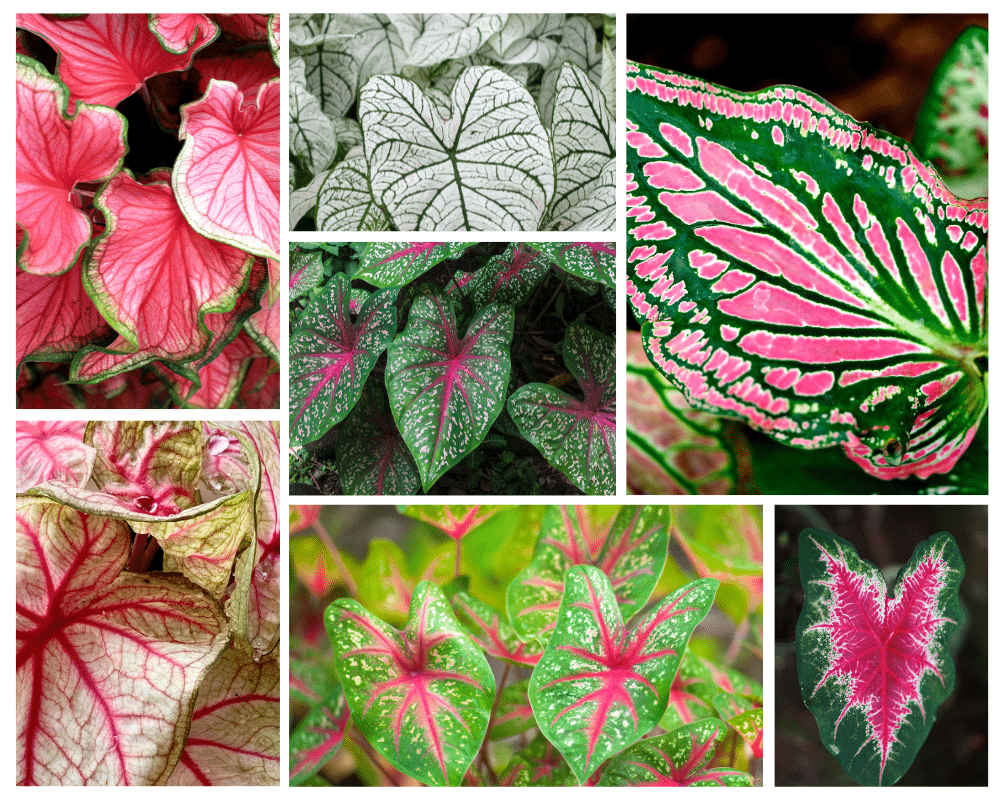
Caladium plants are native to the tropical regions of Central and South America, particularly the Amazon Basin. They thrive in the warm, humid environments of these areas, often growing in open spaces within forests or along riverbanks. The plants naturally go dormant during the dry season, adapting to the cyclical climate of their native habitat. It is this habit of dormancy which allows the caladium producers to grow these in huge fields like those you can tour to see tulips. Then, like tulips it is the bulbs that collectors buy to plant themselves. And when blooming season ends, you can store your caladium bulbs to bloom next year, like some gardeners store tulips.
Caladiums were introduced to Florida in the early 1800s. They were brought over as ornamental plants due to their striking foliage and adaptability to warm, humid climates. Here is a wonderful history written by a French grower of caladiums. You’ll like it!
Ninety percent of all caladiums are raised in the small south Florida town of Lake Placid. Located on a magnificent huge lake, life here goes on at a slow Florida pace (unless it’s time to harvest the bulbs for the rest of us.)
Why is Caladium Production So Centralized?
Lake Placid, Florida, provides the perfect combination of soil and climate conditions for caladiums to thrive:
- Soil: The area has ancient peat bogs, which are highly organic and acidic—ideal for caladium tubers. The soil retains moisture well without becoming waterlogged, which is crucial for healthy growth.
- Climate: Caladiums love warm temperatures, and Lake Placid offers consistently hot days and warm nights during the growing season. The region’s subtropical climate mimics the conditions of the Amazon Basin, where caladiums originate.
- Seasonal Triggers: The area’s mild winters and specific frost timing allow caladiums to gather energy and form larger tubers. The first cool weather in mid-October helps trigger the natural cycle of leaf drop and dormancy, ensuring the bulbs are ready for the next season.
These unique factors make Lake Placid a haven for caladium farming, earning it the title of “Caladium Capital of the World.”
Can I Grow These Plants in My Garden, Wherever I Am?
Adding tropical plants to summer gardens in climates throughout the world is growing in popularity as gardeners learn the opportunities it brings. Gardeners everywhere appreciate the lush features that ginger plants, hibiscus, orchids and other tropical plants add.
When to Plant Your Caladiums
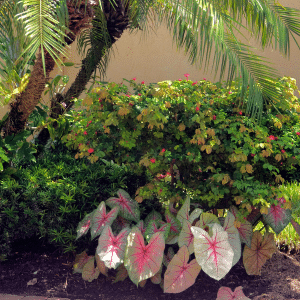
- Timing: Start planting caladium bulbs indoors in late winter or early spring, about 6–8 weeks before the last frost date in your area. This gives them a head start before outdoor planting.
- Soil Temperature: Wait until the soil temperature is consistently above 65°F (18°C) before planting the bulbs outdoors or transplanting them out. Cold soil can cause the bulbs to rot.
How to Grow the Bulbs
- Start Some Indoors:
- Plant the bulbs in pots filled with well-draining, nutrient-rich soil.
- Place them in a warm spot with indirect sunlight.
- Water sparingly until you see growth, then increase watering to keep the soil slightly moist.
- Outdoor Transition:
- Once the weather warms up, harden off the plants by gradually exposing them to outdoor conditions over a week.
- Choose a location with partial shade or filtered sunlight for planting.
- Planting Outdoors:
- Space the bulbs 6–12 inches apart and plant them 2–3 inches deep, with the knobby side facing up.
- Water thoroughly after planting.
Caring for Them
- Watering: Keep the soil consistently moist but not soggy.
- Fertilizing: Use a balanced, slow-release fertilizer every 4–6 weeks during the growing season.
- Winter Storage: In colder climates, dig up the bulbs before the first frost. Let them dry, then store them in a cool, dry place until the next planting season. This is from the University of Missouri with help from storing the bulbs.
Caladiums can also be grown as houseplants if you prefer to keep them indoors year-round. Let me know if you’d like more tips
- Florida Boys Caladiums: Located in Lake Placid, the “Caladium Capital of the World,” they are fourth-generation farmers with a reputation for high-quality bulbs. You can visit their website or contact them at (863) 699-9198.
- Caladium Bulb Company: Based in Lakeland, they specialize in native Florida caladium bulbs and offer a variety of flower bulbs and garden accessories. Their contact number is (863) 680-8080.
- Caladium Bulbs 4 Less: Also in Lake Placid, they provide top-quality caladium bulbs and other magnificent bulbs. You can reach them at (863) 465-2852.
- For a complete list of sources see this one from the Lake Placid Fl Chamber of Commerce.-
- Search Directory | Lake Placid Chamber of Commerce
- If you are in Florida in the summer this is the link toward the annual Caladium Festival in July.
- www.caladiumfestival.org
Color Choices for Caladiums
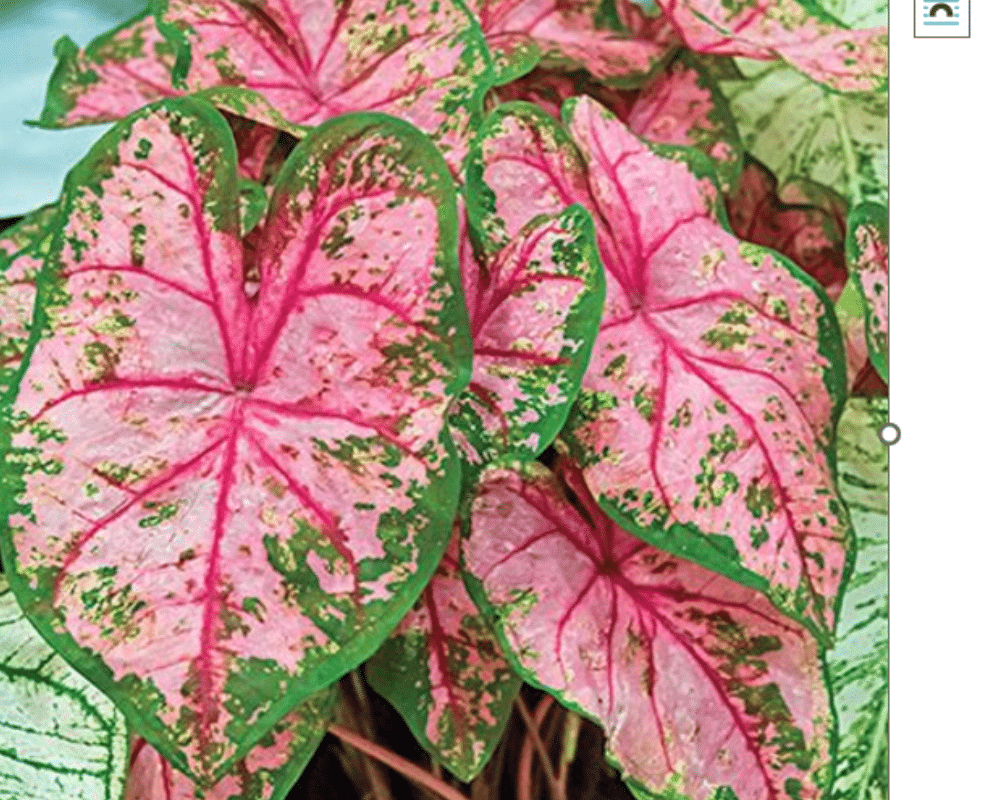
White Caladiums
You can find caladium bulbs sold as white, that range from pure translucent white to white with colored flecks, edges, or veins. Last year I added this one called “white queen,” have a look and see if it suits your garden.
- White Christmas: Elegant white leaves with deep green veins.
- Candidum: Bright white leaves with soft green borders and veins.
- Moonlight: Almost translucent white leaves with subtle green margins.
- Here are some photos of white offerings,
- Pink Symphony: Light pink centers with white edges and green veins.
- Carolyn Whorton: Bright pink leaves with darker pink veins and green edges.
- Miss Muffet: Chartreuse green leaves splashed with pink dots.
- You will see more pink choices on this page.
- Postman Joyner: Intense red leaves with green edges and a hint of pink.
- Florida Cardinal: Deep red, heart-shaped leaves with contrasting green borders.
- Fanny Munson: Red leaves veined with green, giving a dramatic look.
Other Colors
One reason for Florida’s success is the new plants developed by the University of Florida. This link will take you to some showing orange and yellow shades. I have been adding these to containers and hanging baskets to experiment.
Some Ideas for Using Your Caladiums
Caladiums can be a stunning and versatile addition to any garden. Their vibrant, heart-shaped leaves bring a tropical flair, and they thrive in both sunny and shady spots. Here are some ideas to make the most of them.
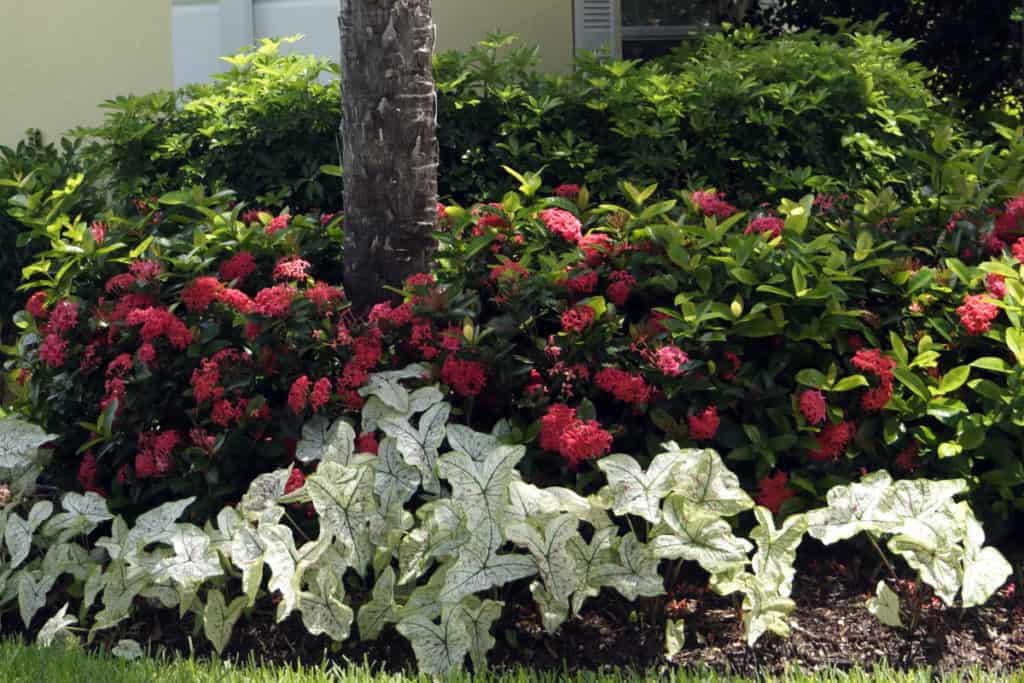
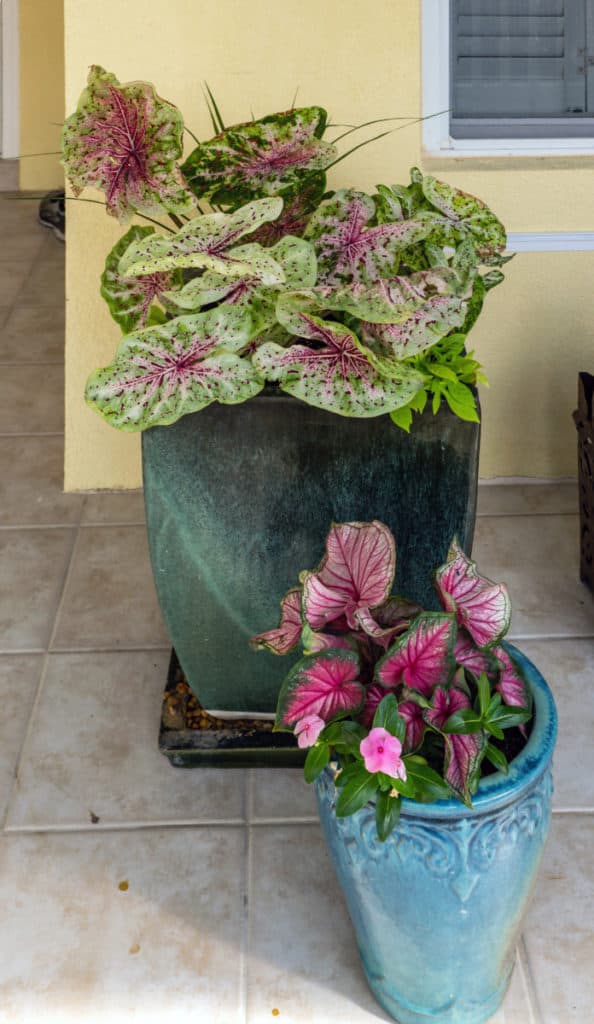
- Borders and Edging: Use caladiums along garden paths or as borders around flower beds. Their bold colors create a striking outline that draws attention.
- Container Gardening: Plant caladiums in decorative pots or hanging baskets. They’re great for adding height and vibrant color to patios, porches, or balconies.
- Mixing with Perennials: Pair caladiums with ferns, hostas, or impatiens. The combination of textures and shades makes for a lush and dynamic garden bed.
- Accent Plants: Use caladiums as focal points in your flower beds. Their colorful foliage can complement or contrast with other plants for added visual interest.
- Shade Gardens: Brighten up shaded areas with caladiums. They thrive in low light and bring life to spots where flowering plants might struggle.
- Seasonal Displays: Caladiums are perfect for summer displays. Plant them in clusters to create a bold, seasonal statement in your garden.
- Tropical Themes: Combine caladiums with other tropical plants like elephant ears, cannas, or banana plants to create a lush, exotic oasis.
- Understory Planting: Place caladiums beneath trees or taller shrubs. Their vibrant leaves can add a splash of color to these often-overlooked spaces.
Summary,
Caladium bulbs are a remarkable addition to add vibrant color and lush foliage to your garden or home. When purchasing bulbs, consider the size and quality—larger bulbs generally produce more robust plants. Look for firm, blemish-free bulbs from dealers or direct from the farm. Choose varieties suited to your climate and light conditions; most caladiums thrive in partial to full shade, but some newer hybrids tolerate more sun. Timing is key—order your bulbs in time for delivery in the spring when the soil temperature consistently reaches around 65-70°F for optimal growth.
Planting and caring for caladium bulbs is very direct. Start by selecting a location with well-draining soil and amend it with organic matter for added nutrients. Plant the bulbs about 2 inches deep with the knobby side facing up, spacing them 6-12 inches apart to allow for their broad leaves to spread. Water thoroughly after planting, and continue to water regularly to keep the soil moist but not soggy. As the plants grow, apply a balanced fertilizer to encourage healthy foliage. At the end of the growing season, in cooler climates, you can dig up the bulbs, let them dry, and store them in a cool, dark place for replanting next year. With minimal effort, caladiums can bring a striking tropical flair to any space!
